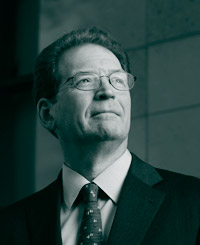SPRING 2014 CONTENTS
Home
Fresh starts for hearts
Cardiovascular medicine looks to stem cells for answers
Hiding in plain sight
A high-cholesterol gene
A change of heart
A conversation with Dick Cheney
Switching course
Untangling a birth defect decades later
Dear Dr. Shumway
A boy, two frogs and an airmail letter
Easy does it
Aortic valve replacement without open-heart surgery gains ground

DOWNLOAD PRINTABLE
ISSUE (PDF)


Glenn Matsumura

It was a cool evening in Palo Alto on Jan. 6, 1968, when Stanford University School of Medicine professor Norman Shumway removed the failing heart of steelworker Mike Kasperak and replaced it with the heart of the late Virginia White.
Dr. Shumway didn’t like the limelight, but as he and his team performed the first successful human heart transplant in the United States, journalists climbed the walls of Stanford Hospital to try to catch a glimpse of the historic operation.
It was the kind of pioneering breakthrough that could happen only at Stanford Medicine. Drawn to the most difficult problems, we are known for developing the paradigms that shape the future. And we achieve these breakthroughs by integrating our clinical, research and educational missions. Dr. Shumway was an extraordinary surgeon, but he was also a prodigious researcher and an exceptional teacher and mentor. He was a consummate academic physician.
Years of laboratory work had prepared Dr. Shumway and his team for that first heart transplant. And after that first trial in humans, he went back to the lab to improve the procedure — developing new techniques for overcoming immune rejection, predicting organ rejection and preserving donor hearts — when many other centers had abandoned it because early results were so dismal. His vision and perseverance have paid dividends for the thousands whose lives have been prolonged by this now-standard operation.
One of Dr. Shumway’s trainees is Dr. William Brody, president of the Salk Institute and a Stanford University trustee. Dr. Brody says that he and his colleagues used to joke that Norman Shumway was “the world’s greatest first assistant” for the trust he put in his trainees, believing that “how” is more important than “who.” Dr. Shumway’s patients had astounding results. His trainees went on to become national leaders of cardiac surgery.
Since that famous operation nearly 50 years ago, Stanford’s cardiac surgeons have continued to innovate — taking discoveries from the lab to the operating room and bringing new ideas from the operating room back to the lab. Our long list of firsts includes the world’s first combined adult human heart-lung transplant, by Dr. Bruce Reitz, and the world’s first surgical implantation of a ventricular assist device as a bridge to transplantation, by Dr. Philip Oyer.
And our achievements are not limited to adults. Our outstanding pediatric cardiac surgery program has made Lucile Packard Children’s Hospital Stanford an international referral site for complex and challenging open-heart surgeries. The “unifocalization” procedure developed by Dr. Frank Hanley repairs a complex and life-threatening congenital heart defect with a single surgery. In the lab, Dr. Hanley and his colleagues are actively involved in exploring new approaches for surgical repair of pediatric heart defects and disease. In the operating room, they are passing down these innovations to the next generation of heart surgeons.
Today, Stanford’s Department of Cardiothoracic Surgery is under the leadership of another consummate academic physician. On Jan. 1, renowned heart surgeon Dr. Joseph Woo began his tenure as chair, carrying on the legacy begun by Norman Shumway. At once a distinguished investigator, an expert surgeon and a respected mentor, Dr. Woo is an innovator who embodies the academic mission of Stanford Medicine. I cannot wait to see what the department will achieve with his leadership.
Sincerely,
Lloyd Minor, MD
Carl and Elizabeth Naumann Dean of the School of Medicine
Professor of Otolaryngology - Head & Neck Surgery

